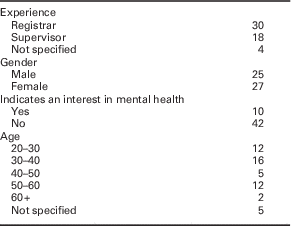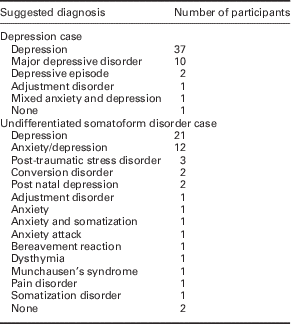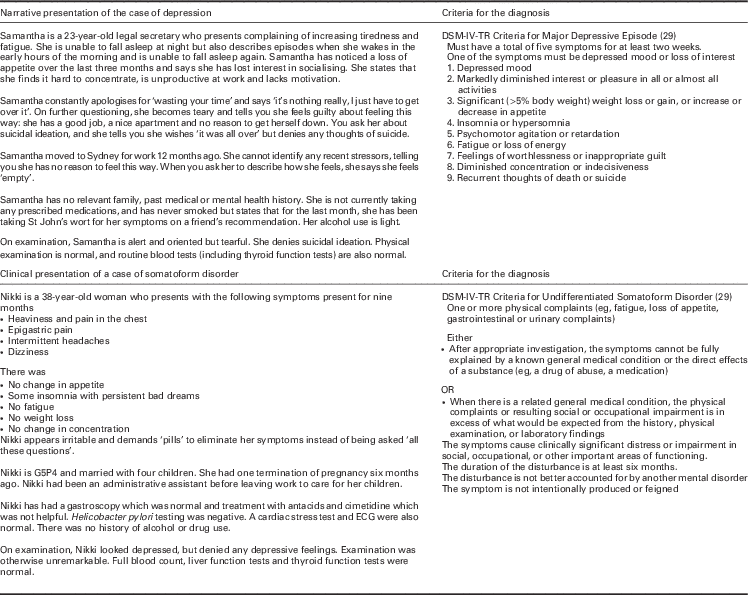Background
Patients with mixed emotional and physical symptoms, but no biomedical diagnosis, have been described for centuries (Oken, Reference Oken2007). However, the way in which their distress is understood, expressed and classified has changed significantly (De Gucht and Fischler, Reference De Gucht and Fischler2002; Sadler, Reference Sadler2002; Broome, Reference Broome2007). The psychiatric classification of these patients has been heavily influenced by the cultural context in which diagnostic systems have been developed (Shorter, Reference Shorter1992). Until recently, these conditions have been classified as somatoform disorders in the Diagnostic and Statistical Manual of Psychiatric Disorders, DSM-IV (American Psychiatric Association, 1994).
Somatoform disorders are present in most cultures (Gureje et al., Reference Gureje, Simon, Ustun and Goldberg1997; Simon and Gureje, Reference Simon and Gureje1999; Gureje, Reference Gureje2004), have been described by a multitude of diagnostic terms (Broome, Reference Broome2007; McFarlane et al., Reference McFarlane, Ellis, Barton, Browne and Van Hooff2008), and frequently co-exist with other psychiatric disorders. At least a third of the symptoms seen in primary care are medically unexplained (Kroenke and Hahn, Reference Kroenke and Hahn1994; Oye, Reference Oye2004) but the prevalence of somatoform disorders is difficult to estimate due to variations in definition and measurement. Recent prevalence studies have estimated prevalence of 15–22% in primary care (Clarke et al., Reference Clarke, Piterman, Byrne and Austin2008; Steinbrecher et al., Reference Steinbrecher, Koerber, Frieser and Hiller2011; Morriss et al., Reference Morriss, Lindson, Coupland, Dex and Avery2012). Somatoform disorders are disabling, with morbidity similar to depression and anxiety (Kroenke et al., Reference Kroenke, Jackson and Chamberlin1997a; Dickinson et al., Reference Dickinson, Dickinson, Degruy, Candib, Main, Libby and Rost2003; de Waal et al., Reference de Waal, Arnold, Eekhof and Van Hemert2004). There is also some evidence for the efficacy of both antidepressant medication and cognitive behavioral therapy treatment (Kroenke, Reference Kroenke2007; Sumathipala, Reference Sumathipala2007).
Recent discussions around the development of DSM-5 have highlighted some of the concerns around issues of classification and definition (Smith et al., Reference Smith, Gardiner, Lyles, Sirbu, Dwamena, Hodges, Collins, Lein, Given, Given and Goddeeris2005; Oken, Reference Oken2007; Regier, Reference Regier2007; Rief and Rojas, Reference Rief and Rojas2007; Radden, Reference Radden2009; Voigt et al., Reference Voigt, Nagel, Meyer, Langs, Braukhaus and Lowe2010b). The DSM-IV somatoform disorders have been criticized for being unhelpful in primary care (Sharpe and Mayou, Reference Sharpe and Mayou2004; Mayou et al., Reference Mayou, Kirmayer, Simon, Kroenke and Sharpe2005), with poor reliability in both clinical practice and research (Fink and Taylor, Reference Fink and Taylor2008; McFarlane et al., Reference McFarlane, Ellis, Barton, Browne and Van Hooff2008).
In this study, the aim was to determine whether the cluster of symptoms identified in each of the diagnostic categories of depression, anxiety, hypochondriasis, somatization disorder and undifferentiated somatoform disorder were recognized by supervisors and registrars. For each cluster, the second aim was to identify which diagnostic terms were in current use. The study did not attempt to explore why general practitioners (GPs) chose each diagnosis, or the symptoms they identified that led them to choose a diagnostic category.
Methods
Cases, questionnaire design and sampling
Prototype cases were sourced from the psychiatric classification literature (the DSM-IV casebook; Spitzer et al., Reference Spitzer, Gibbon, Skodol, Williams and First1994) and de-identified cases from the author’s practice. The cases included an exemplar of depression and anxiety, and three cases of somatoform disorder: hypochondriasis, somatization disorder and undifferentiated somatoform disorder. Each case was carefully presented to include the majority of the diagnostic features required by DSM-IV for each diagnosis.
Directors of Training were approached and asked to participate in the study. Questionnaires were then circulated at an educational event and registrars and supervisors were invited to participate. These cases were presented in paper form in a random sequence. Each case was expressed in either a narrative form, or a summarized clinical form. Examples of two of the cases are presented in Table 1. Participants completed open responses to three questions:
∙ The most likely diagnosis.
∙ Any other diagnoses that may apply to the case.
∙ The key features of the case that led the participant to decide on this diagnosis.
Table 1 Examples of the cases and their criteria

Registrars in their first year of GP training and GP supervisors from Regional Training Programs across Australia were invited to participate. Participants were asked to supply demographic details, current practice context and previous mental health training and experience.
Analysis
Accurate diagnoses (scored 3) included the major classification or sub-classifications of the disorder in DSM-IV or DSM-IV-R or ICD-10. Partly accurate diagnoses (scored 2) included terms used for this diagnosis in previous editions of DSM or ICD, or diagnoses proposed for use in DSM-5. Diagnostic terms outside these categories were scored 1, and those left blank were scored 0.
Diagnostic decisions for each case were compared using the Mann–Whitney test. Performance was also compared between supervisors and registrars.
Results
Fifty-two surveys (30% response) were returned and the characteristics of the sample are outlined in Table 2. Figure 1 shows a strong difference in the accuracy of diagnosis between prototype cases.

Figure 1 Accuracy of diagnosis by case
Table 2 Characteristics of the sample

The marked difference in diagnostic accuracy between the case of depression and the case of undifferentiated somatoform disorder can be seen in more detail in Table 3, showing the frequency of diagnoses given for each case.
Table 3 Frequency of diagnosis for the cases of depression and undifferentiated somatoform disorder

Statistical significance was calculated using the Mann–Whitney test. Diagnostic accuracy on the Anxiety and Depression cases were not significantly different (P∼1.0). Compared against the Anxiety case, accuracy in each of the other three cases was significantly different (P<0.0002). There was no significant difference in performance on the basis of age, gender or experience in practice (P<0.05), calculated using Fisher’s exact test.
Discussion
There was a significant difference in the classification of the cases. Almost all of the participants identified the depression and anxiety cases by their correct diagnostic term. There was also significant agreement with the hypochondriasis case. Interestingly, there is some debate in the literature around whether hypochondriasis is better classified as an anxiety disorder (Phillips et al., Reference Phillips, Lawrence, Price, Greenberg and Rasmussen2003), and this was reflected in the results, with many participants classifying this case as an anxiety disorder rather than hypochondriasis. Given that the treatment is likely to focus on managing anxiety around health and health-seeking behavior, this difference in classification is unlikely to be clinically significant.
The other two somatoform cases showed interesting results. Somatization disorder is rare, because it requires a higher number of symptoms than the less restrictive undifferentiated somatoform disorder. The case of somatization disorder was recognized by almost half of the participants, although a significant proportion of respondents classified this case as depression. Other respondents used synonyms, such as psychosomatic disorder, or terms relating to particular body systems such as irritable bowel syndrome.
In the case of undifferentiated somatoform disorder, there were few references to somatization. While clearly the respondents recognized that the somatoform case represented a psychiatric disorder, they tended to classify the case as depression or anxiety rather than somatization. The diversity of responses between the somatoform cases and the depression cases were highly significant.
There are several possible interpretations of this data.
1. GPs do not recognize the category of somatoform disorder There have been a number of studies focusing on increasing awareness of the diagnostic criteria for the somatoform disorders on the assumption that GPs fail to recognize the diagnosis (Rosendal et al., Reference Rosendal, Bro, Fink, Christensen and Olesen2003). In this study, the more severe form of the disorder, somatization disorder, was recognized more frequently. However, both cases were often diagnosed as depression.
Although somatization disorder frequently co-exists with depression, both patients clearly denied depressed mood. It may be that the participants recognized the presence of a psychiatric disorder, but were unable on the available evidence to distinguish between them and chose the most common alternative psychiatric diagnosis.
2. GPs do not find the diagnosis of somatization clinically helpful and so are reluctant to apply it to some cases There has been criticism of current classification systems for somatoform disorders, because they are not useful in a clinical context (Voigt et al., Reference Voigt, Nagel, Meyer, Langs, Braukhaus and Loewe2010a). Some authors have also criticized GPs for being ‘taxophobic’: reluctant to use psychiatric labels at all (Phillips et al., Reference Phillips, Lawrence, Price, Greenberg and Rasmussen2003). In this study, it could be argued that participants chose to utilize the term ‘somatization’ selectively, because it was used in one case by almost 50% of the participants, and not at all in the second case.
There is also criticism that somatoform disorders overlap significantly with depression and anxiety (Wollburg et al., Reference Wollburg, Voigt, Braukhaus, Herzog and Löwe2012). With the treatment of all three conditions involving antidepressants and cognitive behavioral therapy, there is an argument that differentiating the conditions is unhelpful. This idea is supported by the study data, which shows the majority of respondents diagnosed undifferentiated somatoform disorder as either depression, anxiety or both.
3. GPs use alternative names for somatization There are several proposed diagnostic frameworks in the literature, including abridged somatization (Escobar et al., Reference Escobar, Waitzkin, Silver, Gara and Holman1998), multisomatoform disorder (Kroenke et al., Reference Kroenke, Spitzer, Degruy, Hahn, Linzer, Williams, Brody and Davies1997b), bodily distress disorder (Fink et al., Reference Fink, Toft, Hansen, Ornbol and Olesen2007) and complex somatic symptom disorder (Dimsdale et al., Reference Dimsdale and Creed2009). In this study, there were several synonyms in use for both somatization and undifferentiated somatoform disorder, including psychosomatic disorder, neurasthenia, conversion disorder and masked depression.
4. GPs use alternative paradigms for somatization Current debates around the classification of somatization disorder describe the overlap between somatization disorder and the affective disorders (McFarlane et al., Reference McFarlane, Ellis, Barton, Browne and Van Hooff2008), the personality disorders (Widiger and Samuel, Reference Widiger and Samuel2005) and the functional disorders, syndromes with predominant symptoms in one body system such as irritable bowel syndrome and fibromyalgia (Kanaan et al., Reference Kanaan, Lepine and Wessely2007). In the undifferentiated somatoform case, the participants suggested some alternative diagnoses that used different paradigms, such as chronic pain disorder, prolonged grief reaction, drug seeking behavior and interpersonal stress that represented different ways of understanding the clinical scenario separate to psychiatric classification.
Strengths and limitations of this study
This study had a small response rate, but the large effect size demonstrates a significant difference in the way GPs classify affective disorders such as depression and somatoform disorders. By using cases of depression and anxiety, the study design identified that participants were competent with common mental health diagnoses and by using free text responses, it demonstrated the broad variation of diagnostic frameworks in use in primary care. The study was designed to generate hypotheses, and so was not able to answer the question why the GPs did not use the somatoform disorder diagnoses, but it did support the literature in showing that GPs do not use these diagnostic terms readily.
Implications for practice
In order to manage patients, teach students and registrars and communicate with colleagues, we need to have a common language. This language needs to enable clinicians and researchers to conceptualize and communicate information about somatization disorders using a framework that is valid, clinical useful, and is acceptable to patients and clinicians. Given that these patients commonly present in GP, and suffer significant disability, there must be conversations occurring between clinicians, and between GPs and patients in a variety of contexts. Further research into the language, diagnostic frameworks and clinical reasoning in current use in GP should enrich our understanding of this complex area of practice.
Conclusion
Patients with mental health disorders experience significant disability and GPs express dissatisfaction with current classification systems as they apply in primary care. This study suggests that certain categories of psychiatric disorder are not recognized, even when presented in a prototypical case. Future research needs to explore the language and diagnostic frameworks that novice and expert GPs use in diagnosing and managing patients with mental health disorders. Understanding a common language is the first step in defining a research agenda for this important area of clinical practice.
Acknowledgments
The author gratefully acknowledges the support of the supervisors and registrars who participated in this study and A/Prof Jill Gordon who provided advice on the study design and analysis.
Funding
This research received no specific grant from any funding agency, commercial or not-for-profit sectors.
Conflicts of Interest
None.
Ethics Committee Approval
Ethics approval has been granted from the University of Sydney Human Research Ethics Committee, reference 11502.







